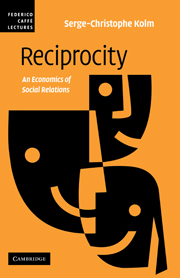Book contents
- Frontmatter
- Contents
- List of illustrations
- Foreword
- Introduction
- Part I Facts and forms
- Part II Motives
- 5 The three worlds of reciprocity
- 6 Balance reciprocity
- 7 Liking reciprocities
- 8 Other reciprocities: continuation, relational, imitation, extended
- 9 Reciprocity and social sentiments
- 10 Reciprocity in the modes of economic realization
- Part III Values and reasons
- Part IV The economics of reciprocity
- Bibliography
- Index
9 - Reciprocity and social sentiments
Published online by Cambridge University Press: 22 September 2009
- Frontmatter
- Contents
- List of illustrations
- Foreword
- Introduction
- Part I Facts and forms
- Part II Motives
- 5 The three worlds of reciprocity
- 6 Balance reciprocity
- 7 Liking reciprocities
- 8 Other reciprocities: continuation, relational, imitation, extended
- 9 Reciprocity and social sentiments
- 10 Reciprocity in the modes of economic realization
- Part III Values and reasons
- Part IV The economics of reciprocity
- Bibliography
- Index
Summary
Introduction
Reciprocities are closely related to a complex of sentiments about society and about one's place in it. The motives for reciprocations are not emotional or motivational atoms. Each is a compound of several such sentiments, and each of these constituent sentiments also applies in vast other domains. Balance reciprocity rests on senses of equality and impartiality, and, sometimes, fairness and equity, distributive or compensatory justice, and all the sentiments that can accompany the sense of moral indebtedness (sometimes questions of dignity, inferiority or dependency), and it is supported by senses of propriety or duty, social or moral norms, and sometimes sentiments of guilt or shame. Liking reciprocity mobilizes affection of various types and intensity, concepts of responsibility, and the sense of self and of social existence. Gratitude mixes balance and liking. Revenge and resentment can mobilize issues of responsibility, senses of imbalance and balance, propriety and impropriety, and sometimes injustice, and they can be motivated by anger or by social norms and shame.
Moreover, fairness and affection may be not only motives for reciprocity but also objects of the relation. Such a reciprocal fairness is an important ingredient in the realization of social justice and social peace. The essential social normative motive of “universalization” – such as Kant's categorical imperative – is a kind of putative reciprocity (“act as if it induced other people to act likewise”). Other sentiments also have some relevance.
This chapter focuses on the relations between reciprocity and these sentiments, and their consequences.
- Type
- Chapter
- Information
- ReciprocityAn Economics of Social Relations, pp. 142 - 150Publisher: Cambridge University PressPrint publication year: 2008

